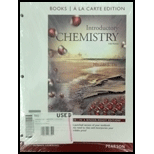
Interpretation:
In each of the given compounds, determine the kind of intermolecular forces existing between their molecules.
Concept introduction:
The attractive forces existing between molecules are said to be intermolecular forces. These forces are the result of mainly three types of interactions:
(a) Dipole–dipole interactions
(b) Dipole–induced dipole interactions
(c) Induced dipole–induced dipole interactions
There are four types of intermolecular forces:
(a) Dispersion forces: These are the intermolecular forces present in all the molecules and atoms by virtue of the electrons present in them.
(b) Dipole–dipole interactions: These are the forces that exist in all polar molecules. They have permanent dipole in which positive end of one permanent dipole is attracted to the negative end of other.
(c) Hydrogen bonding: These forces exist in those molecules having hydrogen atoms bonded directly to the electronegative elements like fluorine, oxygen, or nitrogen.
(d) Ion–dipole forces: Such types of forces exist between the ionic compound molecules.
Want to see the full answer?
Check out a sample textbook solution
Chapter 12 Solutions
Introductory Chemistry, Books a la Carte Edition (5th Edition)
- Which of the following statements about intermolecular forces is( are) true? a. London dispersion forces are the only type of intermolecular force that nonpolar molecules exhibit. b. Molecules that have only London dispersion forces will always be gases at room temperature (25C). c. The hydrogen-bonding forces in NH3 are stronger than those in H2O. d. The molecules in SO2(g) exhibit dipole-dipole intermolecular interactions. e. CH3CH2CH3 has stronger London dispersion forces than does CH4.arrow_forward8.45 Describe how interactions between molecules affect the vapor pressure of a liquid.arrow_forwardUsing the heats of fusion and vaporization for water given in Exercise 99, calculate the change in enthalpy for the sublimation of water: H2O(s)H2O(g) Using the H value given in Exercise 112 and the number of hydrogen bonds formed with each water molecule, estimate what portion of the intermolecular forces in ice can be accounted for by hydrogen bonding.arrow_forward
 Introductory Chemistry: A FoundationChemistryISBN:9781337399425Author:Steven S. Zumdahl, Donald J. DeCostePublisher:Cengage Learning
Introductory Chemistry: A FoundationChemistryISBN:9781337399425Author:Steven S. Zumdahl, Donald J. DeCostePublisher:Cengage Learning Chemistry: The Molecular ScienceChemistryISBN:9781285199047Author:John W. Moore, Conrad L. StanitskiPublisher:Cengage Learning
Chemistry: The Molecular ScienceChemistryISBN:9781285199047Author:John W. Moore, Conrad L. StanitskiPublisher:Cengage Learning Introductory Chemistry: An Active Learning Approa...ChemistryISBN:9781305079250Author:Mark S. Cracolice, Ed PetersPublisher:Cengage Learning
Introductory Chemistry: An Active Learning Approa...ChemistryISBN:9781305079250Author:Mark S. Cracolice, Ed PetersPublisher:Cengage Learning ChemistryChemistryISBN:9781305957404Author:Steven S. Zumdahl, Susan A. Zumdahl, Donald J. DeCostePublisher:Cengage Learning
ChemistryChemistryISBN:9781305957404Author:Steven S. Zumdahl, Susan A. Zumdahl, Donald J. DeCostePublisher:Cengage Learning Chemistry for Engineering StudentsChemistryISBN:9781337398909Author:Lawrence S. Brown, Tom HolmePublisher:Cengage Learning
Chemistry for Engineering StudentsChemistryISBN:9781337398909Author:Lawrence S. Brown, Tom HolmePublisher:Cengage Learning Chemistry: An Atoms First ApproachChemistryISBN:9781305079243Author:Steven S. Zumdahl, Susan A. ZumdahlPublisher:Cengage Learning
Chemistry: An Atoms First ApproachChemistryISBN:9781305079243Author:Steven S. Zumdahl, Susan A. ZumdahlPublisher:Cengage Learning





